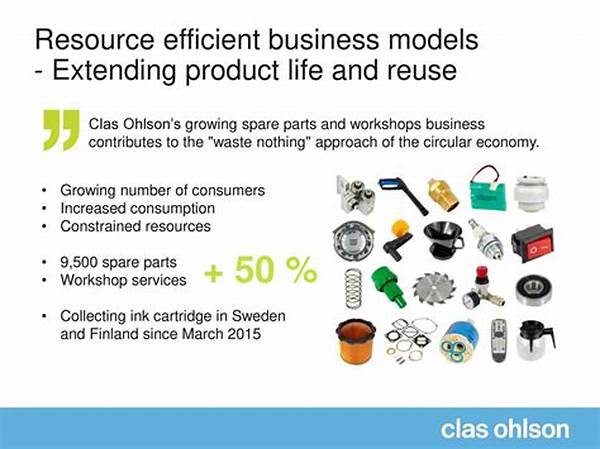In the constantly evolving landscape of global commerce, companies are increasingly recognizing the importance of sustainability. Traditional business models often focus heavily on economic growth at the expense of environmental considerations. However, with the mounting pressures of climate change and resource scarcity, there is an imperative need for resource-efficient business models. Essentially, these models aim to balance profitability with sustainability by promoting the judicious use of natural resources and minimizing waste. Embedding resource-efficient strategies into core business practices not only enhances a company’s reputation but also ensures compliance with regulatory requirements and fosters long-term viability.
Read Now : Addressing Ecommerce Customer Concerns
The Importance of Resource-Efficient Business Models
Resource-efficient business models are fundamental to maintaining ecological balance while driving economic growth. At the heart of these models lies the principle of using resources in a manner that maximizes efficiency and minimizes environmental impact. Businesses are encouraged to innovate processes, implement sustainable practices, and foster a culture of resource optimization. Emphasizing circular economy principles, these models seek to extend the life cycle of products, reduce material consumption, and reimagine waste as a resource. By prioritizing resource efficiency, companies can reduce operational costs, mitigate risks associated with resource scarcity, and enhance their competitive edge. Moreover, embracing such models contributes positively to a company’s social and environmental footprint, aligning business goals with broader societal objectives.
Key Characteristics of Resource-Efficient Business Models
1. Sustainability Integration: Central to resource-efficient business models is the integration of sustainability at every organizational level. Companies strategically embed sustainable practices in their operations, supply chains, and product designs to manage resources prudently.
2. Circular Economy Practices: These business models often incorporate circular economy principles. This involves designing products and processes that emphasize longevity, reparability, and recyclability, thereby minimizing waste.
3. Innovative Technologies: Leveraging state-of-the-art technologies, businesses can optimize resource utilization. Innovations such as IoT, AI, and blockchain can streamline operations and enhance resource efficiency.
4. Consumer Engagement: Engaging consumers in sustainability efforts is vital. Educating them about sustainable choices and encouraging responsible consumption habits are key components of resource-efficient business models.
5. Collaborative Networks: Establishing partnerships and collaborative networks can amplify resource efficiency. Businesses can share resources, knowledge, and best practices to foster mutual growth while minimizing environmental impact.
Read Now : Effective Strategies For Exam Preparation
Strategies for Implementing Resource-Efficient Business Models
Adopting resource-efficient business models requires strategic foresight and comprehensive planning. Firstly, businesses should conduct thorough assessments of their resource footprints to identify opportunities for improvement. Implementing energy-efficient technologies, optimizing supply chain logistics, and adopting waste reduction strategies form the crux of these models. Furthermore, fostering a culture of sustainability through employee training and stakeholder engagement is integral. Organizations must also stay abreast of regulatory changes and innovative practices in the realm of sustainability. By aligning business strategies with resource-efficient objectives, companies not only contribute to environmental conservation but also unlock benefits such as cost savings and risk mitigation.
Challenges in Developing Resource-Efficient Business Models
Developing resource-efficient business models is not without challenges. Companies often face barriers such as high initial investment costs, inadequate infrastructure, and resistance to change. Transitioning from traditional linear models to more sustainable practices requires a radical shift in organizational culture and mindset. Furthermore, the lack of standard metrics for measuring resource efficiency can hinder progress. To navigate these challenges, businesses must focus on genuine leadership commitment, fostering innovation, and leveraging strategic partnerships. By addressing these hurdles, companies can successfully transition towards models that are not only sustainable but also economically viable.
Benefits of Resource-Efficient Business Models
The benefits of adopting resource-efficient business models extend beyond environmental gains. Economically, these models result in significant cost reductions through efficient resource utilization and minimized waste. Resource-efficient practices also promote resilience by reducing dependency on scarce resources and insulating businesses from price volatility. Socially, companies benefit from enhanced reputation and trust among consumers and stakeholders who value sustainability. Additionally, governments and regulatory bodies often incentivize sustainable practices, providing financial benefits. Collectively, these advantages highlight the compelling case for businesses to embrace and invest in resource-efficient practices.
Conclusion
In conclusion, resource-efficient business models represent a paradigm shift in traditional business practices. They acknowledge the finite nature of our planet’s resources and the need for sustainable growth. Businesses that successfully adopt these models are better equipped to address the multifaceted challenges of the modern world. By prioritizing resource efficiency, companies can ensure their long-term success while actively contributing to environmental sustainability. It is imperative that businesses recognize the critical role they play and commit to transforming their operations to align with these progressive models.
